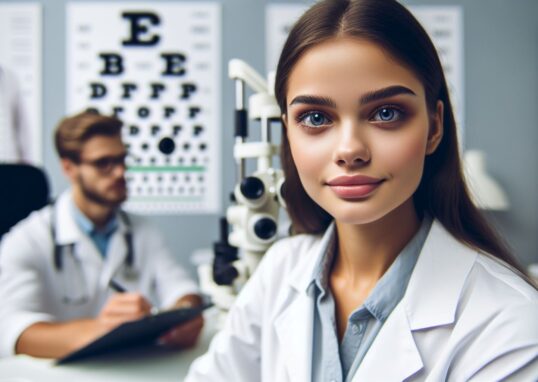
Vision problems are a significant public health concern in the United States, affecting millions of individuals across various age groups. From mild vision impairments to severe blindness, the impact on quality of life and the burden on healthcare systems is substantial. In this section, we explore the prevalence of these conditions and their implications on society.
Prevalence of Vision Loss and Blindness
In the United States, approximately 6 million people have vision loss, and 1 million are blind. A notable number of those affected, more than 1.6 million, are younger than age 40, indicating that vision problems are not just a concern for the elderly. The distribution of vision loss and blindness varies across states and demographics, highlighting the need for targeted interventions and resources. For more detailed statistics, visit the CDC Vision and Eye Health Surveillance System.
Common Eye Diseases Leading to Vision Loss
Several eye diseases are leading causes of vision loss in the United States:
- Age-Related Macular Degeneration (AMD): A leading cause of vision impairment among older adults.
- Diabetic Retinopathy: This condition, associated with diabetes, damages the retina’s blood vessels and can lead to vision loss.
- Glaucoma: Often asymptomatic in its early stages, glaucoma can cause irreversible damage to the optic nerve, resulting in blindness.
For a comprehensive overview of these conditions, refer to the CDC’s Fast Facts on Common Eye Disorders.
Addressing Vision Impairments
While some vision impairments can be corrected or managed, others may lead to permanent vision loss. It is crucial to prioritize eye health through regular check-ups, proper eyewear, and healthy lifestyle choices. Early detection and treatment are key to preventing or slowing the progression of many eye diseases.
Understanding the prevalence and causes of vision problems is the first step towards improving eye health for all Americans. By staying informed and proactive, we can reduce the impact of these conditions on individuals and society as a whole.
Vision Impairment in America
A study by the National Institutes of Health (NIH) has brought to light that a staggering 14 million Americans are affected by vision problems. This significant number represents a variety of visual impairments that citizens across the country face. The NIH study, which is a comprehensive national survey on vision since the mid-1970s, confirms that uncorrected visual impairment is a major public health problem in the United States. For more information on the study, visit the NIH News Release.
Remarkably, out of these 14 million individuals, more than 11 million cases are easily treatable and correctable to 20/40 vision or better. This means that with proper eyeglasses, contact lenses, or refractive surgery, the majority of these vision impairments could be improved, thereby significantly enhancing the quality of life for these individuals. The study emphasizes the importance of routine vision screenings and eye examinations to identify and address treatable causes of vision loss. To delve deeper into the details of the study, you can read the full article at National Eye Institute.
The findings of this study underscore the critical need for increased awareness and access to eye care services. It is a call to action for health care professionals and policymakers to prioritize eye health and prevent avoidable vision loss among the American population.
Understanding Refractive Errors
Refractive errors are the most common type of vision problem, affecting how we see the world. They occur when the shape of the eye prevents light from focusing correctly on the retina, leading to blurred vision. More than 150 million Americans have a refractive error, but many remain unaware that their vision could be improved. Regular eye exams are crucial for diagnosing refractive errors and prescribing corrective measures like eyeglasses or contact lenses. To learn more about refractive errors, visit the National Eye Institute.
According to a study by the National Eye Institute, about half of American adults without 20/20 vision are affected by refractive errors. This significant statistic highlights the need for better awareness and access to vision correction. Women experience refractive errors more frequently than men, and the prevalence increases with age. The study emphasizes the importance of vision care and the potential benefits of corrective lenses. For further details on the study, check out the NEI Fact Sheet.
Understanding refractive errors is essential for maintaining good eye health. By staying informed and seeking regular eye care, we can ensure that refractive errors do not hinder our ability to see clearly.
Common Vision Issues
Nearsightedness (Myopia)
Nearsightedness, or myopia, affects a significant portion of the American population, with estimates suggesting that approximately 41% of Americans experience this condition. Myopia occurs when the eye is longer than normal or the cornea is too curved, causing light to focus in front of the retina. This results in a blurred image for distant objects while close objects remain clear. Treatment options include glasses, contact lenses, or refractive surgery. For more detailed information, visit the National Eye Institute.
Farsightedness (Hyperopia)
About 25% of Americans are affected by farsightedness, known as hyperopia. This condition arises when the eye is shorter than normal, leading to difficulty focusing on close objects while distant objects are seen more clearly. Hyperopia can be corrected with eyeglasses, contact lenses, or surgery. Additional details can be found on the National Eye Institute.
Astigmatism
Astigmatism is a common vision issue that can cause blurred vision at all distances. It occurs due to an irregular curvature of the cornea or lens, which prevents light from focusing properly on the retina. Astigmatism is often present at birth and can occur in combination with myopia or hyperopia. Corrective lenses or refractive surgery are the typical treatments for astigmatism. Learn more at the Mayo Clinic.
Presbyopia
Presbyopia is an age-related condition that typically becomes noticeable in the early to mid-40s and worsens until around age 65. It is characterized by a gradual loss of the eyes’ ability to focus on nearby objects, a natural part of aging. While there is no way to stop or reverse the aging process that causes presbyopia, it can be corrected with eyeglasses, contact lenses, or surgery. More information is available on the American Academy of Ophthalmology.
The Importance of Regular Vision Tests
Regular vision tests are a critical component of maintaining good eye health. They are the most reliable way to diagnose vision issues and determine the need for corrective lenses. Many eye conditions, in their early stages, have no obvious signs or symptoms, making regular comprehensive eye exams key to detecting problems early. A yearly eye exam allows your eye doctor to monitor your vision and eye health over the long-term, and can help detect signs of medical conditions, including diabetes and high blood pressure. For more information on why eye exams are important, visit Optometrists.org.
Vision tests can help prevent 80% of all vision impairment and blindness. The leading causes of vision impairment are refractive errors and cataracts, both of which can be easily corrected when detected through vision tests. To understand more about the importance of vision tests, check out EyeQue.
It is essential to emphasize that vision screenings are not a substitute for a comprehensive eye exam. Screenings can identify apparent problems a person might have with specific visual tasks, but only a comprehensive eye exam can ensure your vision is as clear and comfortable as possible and that you’re free from potentially serious eye diseases that don’t have obvious early symptoms. Learn more about the importance of eye exams at All About Vision.
Conclusion: The Significance of Eye Health
Throughout this article, we’ve explored various aspects of eye health, from common vision issues like myopia and hyperopia to the importance of regular vision tests. We’ve learned that conditions such as astigmatism and presbyopia affect a significant portion of the population and that early detection through comprehensive eye exams is crucial for maintaining optimal eye health.
Regular vision tests are not just about getting the right prescription for glasses or contact lenses; they’re a vital part of our overall health care. They can help detect early signs of serious health conditions like diabetes and high blood pressure, making them an indispensable tool for preventive health maintenance. For more insights on the importance of eye exams, visit Optometrists.org and All About Vision.
We encourage all our readers to prioritize their vision health by scheduling regular eye exams. It’s a small step that can make a big difference in your quality of life and long-term well-being. Remember, taking care of your eyes is taking care of your future.





